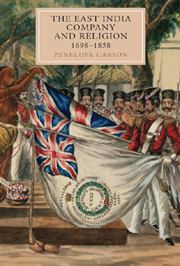Book contents
- Frontmatter
- Contents
- Acknowledgements
- Note on Hinduism
- Abbreviations
- Map of India
- Introduction
- 1 A Christian Company?
- 2 The East India Company, Britain and India 1770–1790
- 3 The 1790s: A Time of Crisis
- 4 The Pillar of Fire Moves Forward: The Advent of British Missionaries 1793–1806
- 5 The Wisdom of the Serpent and the Innocence of the Dove: The Vellore Mutiny and the Pamphlet War 1806–1808
- 6 Troubled Years 1807–1812
- 7 Battle Lines Drawn: Missions, Dissent and the Establishment
- 8 The 1813 Renewal of the Company's Charter: The Religious Public Takes on the Company
- 9 A Turbulent Frontier: The Company and Religion 1814–1828
- 10 A New Dawn? The Era of Lord William Bentinck 1828–1835
- 11 Between Scylla and Charibdis 1836–1858
- Conclusion and Epilogue: Strangers in the Land
- Appendix 1 Presidents of the Board of Control
- Appendix 2 Governors-General and Governors of Madras and Bombay
- Appendix 3 Aide Memoire to Names
- Appendix 4 ‘The Pious Clause’
- Bibliography
- Index
- WORLDS OF THE EAST INDIA COMPANY
Appendix 3 - Aide Memoire to Names
Published online by Cambridge University Press: 05 February 2013
- Frontmatter
- Contents
- Acknowledgements
- Note on Hinduism
- Abbreviations
- Map of India
- Introduction
- 1 A Christian Company?
- 2 The East India Company, Britain and India 1770–1790
- 3 The 1790s: A Time of Crisis
- 4 The Pillar of Fire Moves Forward: The Advent of British Missionaries 1793–1806
- 5 The Wisdom of the Serpent and the Innocence of the Dove: The Vellore Mutiny and the Pamphlet War 1806–1808
- 6 Troubled Years 1807–1812
- 7 Battle Lines Drawn: Missions, Dissent and the Establishment
- 8 The 1813 Renewal of the Company's Charter: The Religious Public Takes on the Company
- 9 A Turbulent Frontier: The Company and Religion 1814–1828
- 10 A New Dawn? The Era of Lord William Bentinck 1828–1835
- 11 Between Scylla and Charibdis 1836–1858
- Conclusion and Epilogue: Strangers in the Land
- Appendix 1 Presidents of the Board of Control
- Appendix 2 Governors-General and Governors of Madras and Bombay
- Appendix 3 Aide Memoire to Names
- Appendix 4 ‘The Pious Clause’
- Bibliography
- Index
- WORLDS OF THE EAST INDIA COMPANY
Summary
Some of the names are rather confusing. This is a short aide-memoire for those names that might pose difficulties.
William Carey, snr (1761–1834), first Baptist missionary to India
William Carey, jnr (1787–1852), his son, also a missionary in Bengal
Charles Grant, snr (1746–1823), Chairman of the Company for many years, MP
Charles Grant, jnr (1778–1866), Chairman, 1830–1834. Lord Glenelg, 1835, MP
Sir Robert Grant (1779–1838), Charles's second son, Governor of Bombay, 1834–1838
Warren Hastings (1732–1818), Governor-General of Bengal, 1774–1785
Francis Rawden Hastings (1754–1826), 1st Marquess of Hastings, second Earl of Moira, Governor-General, 1813–1822
Zachary Macaulay (1768–1838), abolitionist and Governor of Sierra Leone
Colin Macaulay (1799–1853), his nephew, first Resident at Travancore, 1800–1813
Thomas Babington Macaulay (1800–1859), Zachary's son; commissioner of the Board of Control, 1832–3, then law member on the Supreme Council, 1834–8, president of the GCPI, MP, 1st Baron Macaulay (1857)
Sir Thomas Munro (1761–1827), Governor of Madras, 1819–1827
Colonel John Munro, Resident of Travancore, 1813–1819
James Monro, Collector of Palamcottah in the 1820s
Beilby Porteus (1731–1809), Bishop of London, 1787–1808
Revd Willliam Porteous (1735–1812), Church of Scotland Minister, Scottish Divine, prolific correspondent with Henry Dundas
Daniel Wilson (1777–1858), Bishop of Calcutta, 1834–1858
Horace Hayman Wilson (1786–1860), assistant East India surgeon, then assay master at Calcutta Mint; secretary of the Asiatic Society of Bengal, 1811–1833, member of the General Committee of Public Instruction, 1823–1832, professor of Sanskrit at Oxford, librarian at East India House, 1836–1860.
- Type
- Chapter
- Information
- The East India Company and Religion, 1698-1858 , pp. 248 - 249Publisher: Boydell & BrewerPrint publication year: 2012

